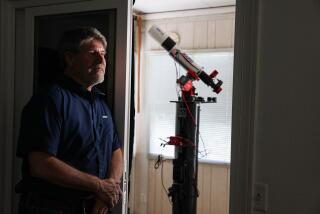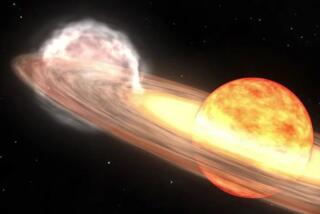An amateur astronomer testing a new camera happens to catch a supernova as it’s being born
- Share via
Peering at a distant galaxy, an amateur astronomer in Argentina managed to capture a star in the act of going supernova. The chances of this discovery, scientists say, are 1 in a million at best.
This lucky find, described this week in the journal Nature, resulted in the first images of the sudden brightening caused by a shock in the star’s core — a process that had been theorized but never observed.
“This is the first confirmation of the existence of this phase, which is really in agreement with the models,” said lead author Melina Bersten, an astrophysicist at the Instituto de Astrofisica de La Plata in Argentina.
The supernova, SN 2016gkg, could shed fresh light on the end stages of a star’s life.
SN 2016gkg was spotted in September 2016 by study coauthor Victor Buso, an amateur astronomer based out of Rosario, Argentina. Buso had been testing a new camera on his 16-inch telescope by aiming it at spiral galaxy NGC 613, which lies roughly 80 million light-years away in the constellation Sculptor.
After taking a series of short-exposure photographs, Buso took a look at his work and noticed, at the end of one of the galaxy’s spiral arms, a bright point in the later images that hadn’t been there in the earlier ones.
It takes experience to be able to notice such a tiny but significant change, said Gaston Folatelli, an astronomer at the Instituto de Astrofisica de La Plata and one of the study’s authors.
“Victor was really very lucky — cannot deny that — but also he had enough expertise to be able to see the object and to realize that this was possible,” said Folatelli, who helped lead the work with Bersten.
Buso put the word out. Within hours, telescopes around the world had been trained on the bright object. Astronomers continued to study it for two months, breaking up the light into different wavelengths to better understand the nature of the explosion — and the dying star that fueled it.
Supernovas are the violent, explosive deaths of massive stars. They release energy across the electromagnetic spectrum from X-rays to visible light and radio waves, and are so powerful that they produce heavy elements that the nuclear fusion in their hearts could never forge in life.
The light generated by the first hours of that supernova explosion could potentially reveal much about the structure and makeup of a star’s surface just before it died. But supernovas are unpredictable at best, and catching that first brightening is exceedingly difficult, Folatelli said.
In the paper, the authors estimate the odds of spotting this crucial early stage at 1-in-a-million or 1-in-10-million chance.
(Keep in mind, Rosario is low flatland and usually quite humid — less-than-ideal conditions in which to perform astronomy. The fact that Buso was able to pick out the supernova in such conditions was also a lucky break, Folatelli said.)
By studying the light coming from this celestial apparition, the researchers found that it was a Type IIb supernova, one that may have come from a weird class of stars known as yellow supergiants.
That was a little surprising, Bersten explained, because when a solo star goes supernova it’s more often something like a red supergiant (a cooler, inflated star) or a more blue-toned variable star (a hotter, denser star). But when yellow supergiant stars are in binary systems, she added, the models show that it’s no longer a stretch that they’d go supernova.
The researchers also looked back in data from the Hubble Space Telescope, pre-explosion, and found a stellar candidate that does indeed have some characteristics of a yellow supergiant.
The original star, they say, may have weighed in around 20 solar masses — although it had probably shrunk to just five solar masses before it went supernova, as the gravitational tug of its companion star siphoned mass away.
The astronomers say they’ll continue to study SN 2016gkg. The supernova’s light curve may be able to reveal more about the material surrounding the star, which could help provide more insight into how stars in binary pairs pull mass off of each other — and how this relationship might affect a star’s evolution.
So far, the supernova’s behavior seems to match fairly well with their expectations, she added. But as the researchers dig deeper into the data and look for subtler inconsistencies, they may be able to build a more nuanced portrait of stellar deaths.
Finding more such events to study will be tricky, though. Even as scientists hunt for supernovae, hoping to catch them early in the process, the next discovery may also require a healthy dose of luck — and all the help they can get.
“I would hope the amateur astronomers are encouraged to do more of this,” Folatelli said.
Follow @aminawrite on Twitter for more science news and “like” Los Angeles Times Science & Health on Facebook.
MORE IN SCIENCE
Mad about L.A.’s air quality? Blame common products like hairspray and paint, not just cars
Medic! Ants injured while hunting for termites get help from paramedic-style triage system
Scientists take an atomic clock on the road and use it to measure the height of a mountain







